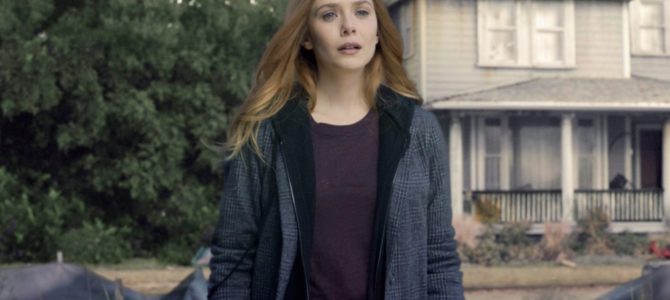
When the Cowardly Lion met the Wizard of Oz, the Wizard said to him, “You, my friend, are a victim of disorganized thinking. You are under the unfortunate impression that just because you run away you have no courage; you’re confusing courage with wisdom.”
With the conclusion of “WandaVision,” it’s quite possible that the show’s heroine was suffering from a similar level of disorganized thinking, but also similar heights of courage and wisdom.
This isn’t just because the series finale featured a nod to “The Wizard of Oz” — albeit a little on the nose, what with the scene of Agnes’s boots beneath the house — there’s also the fact that the series started in black and white before transitioning to color.
Beyond that, however, lies an even grander parallel. Much as Dorothy always had the option to go home, so did Wanda always had that same choice.
For Dorothy, going home didn’t mean destroying all she loved, so the parallel isn’t perfect. But, as with Wanda, Dorothy had agency. Also, like Wanda, while she was weathering maleficent forces, she remained the master of her destiny.
The Choice to Destroy, Or to Love
It’s the choice the two characters were faced with that separates them. Dorothy only had to click together her scarlet shoes to leave a world hostile to her. Wanda, on the other hand, had to become the Scarlet Witch to hostilely destroy a world that surrounded her with love — mostly love, as it were.
The spell she cast to create the Hex was imperfect and the inhabitants knew their reality was fiction, that instead they were imprisoned in Wanda’s creation. Perhaps it’s fitting the only escape was for Wanda to embrace the dark edges of her power and become the witch she’d forgotten she was.
There was also Agnes — the only other truly sentient inhabitant of Westview — the witch who pushed Wanda to unconsciously explore her powers and, ultimately, press them to the limits.
As we saw foreshadowed in Episode 8, and which became clear in the finale, Agnes’s deadliest power was her ability to Aikido magic against those who deployed it in her direction. For that to work to its greatest potential, Agnes needed Wanda to unleash her full fury.
But she misread Wanda’s ability to read the scene. Wanda may not have comprehended how she controlled her surroundings early on, or how she controlled them, but she quickly realized they were her scenes. Indeed, she was the director.
The Excesses of a Disorganized Mind
With the series finale, Wanda courageously chose to fully absorb reality. Her husband, her children, her life was the products of her disorganized thinking — but also wisdom. Life inside the Hex may have been artificial, but Wanda came to realize true heroism demanded she run away … at least until she couldn’t.
Whether or not she would have come to that realization with Agnes is debatable. Normally, the villain needs the hero. In the case of “WandaVision,” however, the hero needed the villain more. The cracks in the façade were not dependent on Agnes. She was, however, an effective catalyst.
And so, Wanda awoke to her reality. Her visions of a dead Vision were proven to be memory instead of fantasy. Her children turned out to be a product of her imagination. The city she occupied ended up being a factory town of the worst variety. Yet, that was her happiness. To click her ruby heels would mean she would abandon it all.
And still, she clicked her heels — not with gusto, not with joy, she clicked them with reticence. She clicked them knowing that all she held dear would evaporate, as though she’d snapped her fingers while wearing the Infinity Gauntlet.
You Can Go Home Again
Wanda, whose powers would not exist absent misery, chose to use them again to face misery head-on. For those of us who wondered if she’d end up the villain of the series, there was our answer. She is complicated, but in Westview, she was not evil. When offered multiple opportunities to embrace evil, by her own creation or by Agnes’s, she turned away. Rather than punishing others in an effort to absorb their fleeing happiness, Wanda instead turned into her loneliness.
Or, to cross franchises, as “WandaVision” did with Quicksilver, she could have died the villain, but she lived long enough to see herself become the hero.
The Show is Over, but the Story Continues
While “WandaVision” resides in the Marvel Cinematic Universe, its ethos reminds us comics can tap into our shared humanity. Sure, the fights are epic, the special effects magnificent, and the characters fantastical, but at the core, they show us that we’re all pretty much the same, regardless of relative power. We crave meaning, community, family, and — above all else — we want love. We want to be human, particularly when we don’t feel like one.
What “WandaVision” relayed so poignantly was our capacity to choose humanity, even when our part of the human experience is beset by suffering.
At the end of “Infinity Wars,” we saw Thanos in his cabin, content with the aftermath of his carnage. He had no other goals. He’d achieved the destruction he desired. Yet, at the end of “WandaVision,” we saw Wanda, also in a remote cabin, desolate over the evil she’d inflicted. We also see her, with more than a little foreshadowing, plotting the undoing of the carnage she caused.
And with the final scene, with even more foreshadowing — this time with a nod to “Dr. Strange” — we saw that while “WandaVision” is finished, Wanda Maximoff is not. In fact, she’s likely just getting started, as we all should.









